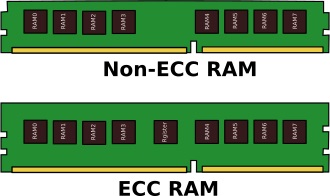Buffered, Unbuffered, Registered Memory, What is the Difference?
By Stephen Bucaro

Buffered and Registered memory are the same thing. The "buffer" is a register that resides
between the system's memory controller and the RAM. The buffer is often, but not always,
used to provide ECC (Error Checking and Correction). ECC is an extension to parity
error checking, except that it uses multiple bit to not only detect errors, but also
to automatically correct them.
EEC RAM is slower than unbuffered memory because memory operations in unbuffered memory
configurations go directly from the controller to memory, while in registered memory
configurations the commands are sent first to the memory banks registers before being
sent to the memory modules.
Unbuffered memory is used in desktops, notebooks, and mobile devices. In fact most CPUs
used in these devices have memory controllers that do not support buffered memory. That's
because these devices need speed and low-power consumption. Most servers however use buffered
memory. Even though buffered memory is more expensive, ECC is considered essential in a
server where system stability is important.
More Computer Anatomy Articles:
• A Definitive Guide on How to Choose Your New PC
• Understanding Your PC's CPU Clock Speed and Front Side Bus
• Device Driver Basics
• Understanding Graphic Cards
• SDRAM Types: DDR, DDR2, DDR3, DDR4
• All About Your Computer's BIOS
• Why Does My Hard Drive Show Less Space Than the Specification?
• Understanding PC Data Buses
• PC Keyboards
• CPU Sockets Roundup
|

